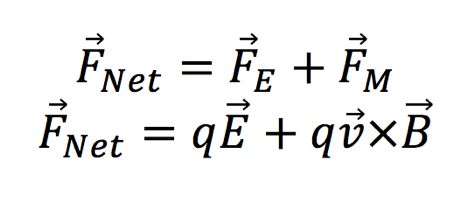Combining Electric and Magnetic Forces
Claimed by Alana Kaplan
PLEASE DO NOT EDIT THIS PAGE. COPY THIS TEMPLATE AND PASTE IT INTO A NEW PAGE FOR YOUR TOPIC.
Short Description of Topic
The Main Idea
When a charged particle is moving through a space with present electric and magnetic forces, if the forces are not balanced, the particles trajectory will change. It is important to remember that though the forces, observably, interact with a particle in different patterns, their effects can be quantitatively be compared.
A Mathematical Model
Electric Forces
- • A particle being acted upon by an electric force will move in a straight line, in the path, or negative path depending on charge, of the the electric field line (See Figure 1) .
- • Electric fields point in a direction radially outward/ inward of a charged particle. There are four possible scenarios for the interaction of 2 charged particles:
- 1) A (-) charged Particle(1) is acting on a (-) charged particle(2)
- • Particle(2) feels force pointing radially outward from Particle(1)
- 2) A (+) charged Particle(1) is acting on a (-) charged particle(2)
- • Particle(2) feels force pointing radially inward toward Particle(1)
- 3) A (-) charged Particle(1) is acting on a (+) charged particle(2)
- • Particle(2) feels force pointing radially inward toward Particle(1)
- 4) A (+) charged Particle(1) is acting on a (+) charged particle(2)
- • Particle(2) feels force pointing radially outward from Particle(1)
- 1) A (-) charged Particle(1) is acting on a (-) charged particle(2)
The electric force formula is as follows:
Magnetic Forces
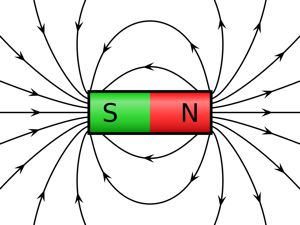
- • The magnetic force on a charged particle is orthogonal to the magnetic field.
- • The particle must be moving with some velocity for a magnetic force to be present.
- • Particles move perpendicular to the magnetic field lines in a helical manner (See Figure 2)
- • To find the magnetic force, you can use the Right Hand Rule as follows (See Figure 3):
- 1) Thumb in direction of the velocity
- 2)Fingers in the direction of the magnetic field
- 3) Your palm will face in the direction of the Magnetic Force
The magnetic force on an object is:
Note that if the velocity and magnetic field are parallel the magnetic force is zero.
Electric and Magnetic Forces Combined
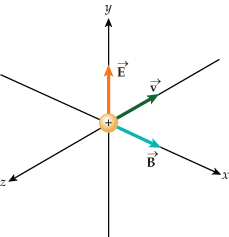
The net force acting on a particle passing through a magnetic and electric field is:
This net force calculation is known as "Lorentz Force"
When the net force is equal to zero, the velocity stays constant. The net force is equal when:
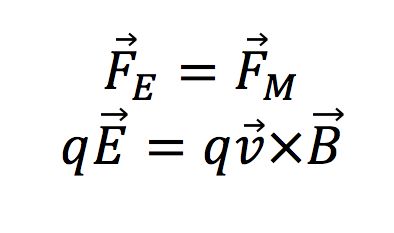
As seen in Figure 4 , when the net forces acting on a particle are balanced the electric field, magnetic field, and velocity vector are all perpendicular to each other. The electric and magnetic forces are equal but opposite. When forces are not balanced the trajectory of the the particle will change. The Lorentz Force calculation is one that is used now in many different applications.
Examples
Simple
Q: A proton is moving with velocity 7e8 in the +x direction. The trajectory of the proton is constant. There is an electric field in the area of 3.6e7 in the +y direction. Calculate the direction and magnitude of the present magnetic field?
Middling
Difficult
Connectedness
The Lorentz Force principle has been a component in many modern day inventions and critical building block for many physics principles. With known forces, we can calculate the very important figure, the speed of a moving particle.
Application: Velocity Selector
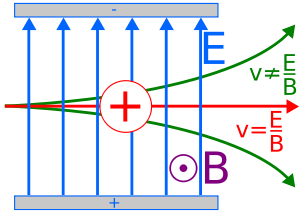
The Velocity Selector is a device used to filter particles based on their velocity. A Velocity Selector uses controlled, perpendicular, electric and magnetic fields to filter certain charged particles (See Figure 5 ). Particles with the correct speed will be unaffected while other particles will be deflected. This technique is used in technologies such as electron microscopes and spectrometers. Be sure to show all steps in your solution and include diagrams whenever possible
Hall Effect Lorentz Force Motional Emf
History
Put this idea in historical context. Give the reader the Who, What, When, Where, and Why.
See also
Hall Effect Lorentz Force Motional Emf
Further reading
Books, Articles or other print media on this topic
External links
References
Boundless. “Electric vs. Magnetic Forces.” Boundless Physics. Boundless, 21 Jul. 2015. Retrieved 05 Dec. 2015 from https://www.boundless.com/physics/textbooks/boundless-physics-textbook/magnetism-21/motion-of-a-charged-particle-in-a-magnetic-field-158/electric-vs-magnetic-forces-554-11176/
Chabay, Ruth W., and Bruce A. Sherwood. Matter & Interactions. 4th ed. Vol. 2. Hoboken, NJ: Wiley, 2015. 812-814. Print.
All images found on google image search: https://en.wikipedia.org/wiki/Magnetic_field https://en.wikipedia.org/wiki/Wien_filter http://aplusphysics.com/wordpress/regents/em/electric-field/


